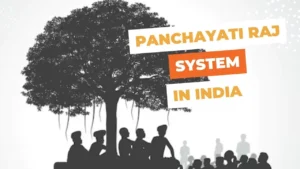In today’s time, where our government is running many schemes for development in different areas, a lot is being done for the development of rural areas. The most important and effective system for this is the Panchayati Raj system. Today we will tell you everything about this system.

Table of Contents
What is Panchayati Raj System?
Panchayati Raj system is such a system, in which development work is done at the local level by the village panchayats. Under this system, work is done at the levels starting from the village level up to the district level. This system gives self-governance to the people of rural India and provides services to the local people according to their needs.
History of Panchayati Raj system
Panchayati Raj system was implemented in India in 1959. This system was incorporated under the Acts of Independent India which were passed by the Parliament. Under this system Gram Panchayat, Mandal Parishad and Zilla Parishad are constituted in rural areas.
3 Tier Structure of Panchayati Raj system
There are 3 Tier Structure in the Panchayati Raj system:
Gram Panchayat
Gram Panchayat is established in rural areas. Its main function is to make plans and adopt works for development in rural areas. It provides services at the local level such as education, health facilities, water etc.
Mandal Parishad
Mandal Parishad is established at the block level. Its main function is to solve the problems of the Gram Panchayats. This level appropriates grants for larger projects than the village level.
Zilla Parishad
Zilla Parishad is established at the district level. Through this level, the government implements its policies and plans at the district level. This panchayat constitute bodies known as boards of directors and committees.
Panchayati Raj System in India
The Panchayati Raj System in India was started in the pre-independence period. In most of the villages people were self-governing and they worked for their own development at their village level. To promote this type of local self-government, the Constituent Assembly announced the formation of the Panchayati Raj system.
The Panchayat Raj Act, 1992 was passed by the Parliament to establish the Panchayati Raj system in India. This act structurally organizes the Panchayati Raj system in India. Under this, instructions have been issued for Gram Panchayat, Mandal Panchayat and District Panchayats.
Government decisions are taken at the local level through the Panchayati Raj system. It empowers the Panchayats to make decisions independently which enables them to solve their own needs and local problems.
The presidents of the bodies operating under the Panchayati Raj system are elected. They are known as Gram Panchayat, Mandal Panchayat and District Panchayat. The chairpersons of these bodies are appointed by the committee, which takes important decisions for local development.
Advantages of Panchayat Raj system
Panchayati Raj system has many advantages. It operates at the local level in the immediate presence of the people. This gives people more power to solve their problems. Apart from this, the rights of the people are also protected through the Panchayati Raj system.
Along with this, many development schemes in India such as National Rural Employment Guarantee Scheme, Land Reform Scheme, Women Empowerment Scheme, Children’s Education and Development Program etc. are operated through Panchayati Raj System.
This opens up more possibilities for development and improvement in rural areas and spreads awareness among rural communities. Through the Panchayati Raj system, development takes place in rural areas in the fields of health, education, water resources development, community development etc.
Challenges of Panchayat Raj System
There are some challenges with the Panchayati Raj system as well. Through this it is more difficult to manage the resources according to the needs of the people. In addition, the members of the panchayats have to work for longer hours than the prescribed hours.
Furthermore, it is also more difficult to focus on agreement and consensus among people. Resolving its disputes is also a challenge.
One of the other challenges is that women are often not elected for representation in villages. Due to this, the voice of women is less heard and problems arise regarding their rights.
Apart from this, proper resources are also required to make the members of Panchayats educated. One of the other challenges is that there is a lack of related resources in rural areas, which prevents the availability of resources to the members of the Panchayats.
Benefits of Panchayat Raj System
There are many benefits of development in rural areas under the successful functioning of Panchayati Raj system. This increases the respect of the public in rural areas and their voice is heard. This leads to development in rural areas in the areas of health, education, water resources development, community development etc.
Apart from this, various schemes are run under Panchayats which prove to be an important step towards development in rural areas. Under these schemes, there is development in the field of employment in rural areas, development in the field of production, rural financial development, water resources development in rural areas etc.
Due to this, socially and economically weaker sections also get benefit in the direction of development. It supports the development of all and enhances harmony among people as a group.
Read Also: 100 Easy General Knowledge Questions and Answers
Conclusion
Panchayati Raj System is an important step in building a strong democracy in the rural areas of India. This is a significant step towards development in rural areas which also benefits people from economically and socially weaker sections. Apart from this, it leads to the development of various sectors in the rural areas which ultimately also plays an important role in the development of the country.
So, we all should understand the importance of this system and support it. We need to bring every section of the society together to strengthen this system. This will be a big step towards the development of our country and we will be able to move towards a better future for all of us.